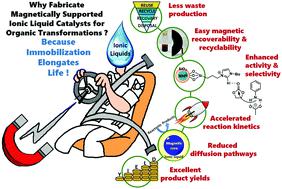当前位置:
X-MOL 学术
›
Mater. Horiz.
›
论文详情
Our official English website, www.x-mol.net, welcomes your feedback! (Note: you will need to create a separate account there.)
Magnetically supported ionic liquids: a sustainable catalytic route for organic transformations
Materials Horizons ( IF 13.3 ) Pub Date : 2020-08-27 , DOI: 10.1039/d0mh01088j Radhika Gupta 1, 2, 3, 4, 5 , Manavi Yadav 1, 2, 3, 4, 5 , Rashmi Gaur 1, 2, 3, 4, 5 , Gunjan Arora 1, 2, 3, 4, 5 , Priya Yadav 1, 2, 3, 4, 5 , Rakesh Kumar Sharma 1, 2, 3, 4, 5
Materials Horizons ( IF 13.3 ) Pub Date : 2020-08-27 , DOI: 10.1039/d0mh01088j Radhika Gupta 1, 2, 3, 4, 5 , Manavi Yadav 1, 2, 3, 4, 5 , Rashmi Gaur 1, 2, 3, 4, 5 , Gunjan Arora 1, 2, 3, 4, 5 , Priya Yadav 1, 2, 3, 4, 5 , Rakesh Kumar Sharma 1, 2, 3, 4, 5
Affiliation

|
From solvents to catalytic applications, ionic liquids have received burgeoning interest ever since their discovery. They belong to a class of salt-like materials that have unusually low melting temperatures. In recent years, the concept of supported ionic liquids has caught the eye of the scientific community due to their supremacy over their homogeneous counterparts. Amongst the available supports, magnetic materials have emerged as exceptional solid supports that provide proficient recovery and reusability features for ionic liquids. The present review exhaustively summarizes the most recent advances in the development of magnetically supported ionic liquids reported in the field of catalysis. This class of recyclable catalytic ionic liquids includes the immobilization of functionalized molten salts containing imidazolium, pyridinium, ammonium, piperidinium, phosphonium and many other precursors, including deep eutectic solvents, over magnetically modified nanocomposites such as core–shell nanoparticles, graphene oxide nanosheets, carbon nanotubes and mesoporous materials. Additionally, magnetically supported poly(ionic liquid) materials are explicitly documented. Concomitantly, synthetic applications of the fabricated materials are highlighted in the domain of catalysis, where both metal-free and metal-containing ionic liquids are personified as catalytic entities rather than green alternative media or supports for organo/metal catalysts.
中文翻译:

磁性负载的离子液体:有机转化的可持续催化途径
从溶剂到催化应用,自发现以来,离子液体就受到了迅速发展的关注。它们属于熔融温度极低的一类盐类材料。近年来,由于负载型离子液体比同类离子液体具有优势,因此受到了科学界的关注。在可用的载体中,磁性材料已成为卓越的固体载体,可为离子液体提供出色的回收率和可重复使用性。本综述详尽总结了催化领域中报道的磁性负载型离子液体的最新发展。这类可循环使用的催化离子液体包括固定化含咪唑鎓,吡啶鎓,铵,哌啶鎓,磷鎓和许多其他前体,包括深共熔溶剂,位于磁性修饰的纳米复合材料上,例如核-壳纳米颗粒,氧化石墨烯纳米片,碳纳米管和介孔材料。此外,明确记录了磁性负载的聚(离子液体)材料。伴随地,在催化领域强调了制造材料的合成应用,其中无金属和含金属的离子液体都被拟作催化实体,而不是绿色替代介质或有机/金属催化剂的载体。磁性支持的聚(离子液体)材料已明确记录。伴随地,在催化领域强调了制造材料的合成应用,其中无金属和含金属的离子液体都被拟作催化实体,而不是绿色替代介质或有机/金属催化剂的载体。磁性支持的聚(离子液体)材料已明确记录。伴随地,在催化领域强调了制造材料的合成应用,其中无金属和含金属的离子液体都被拟作催化实体,而不是绿色替代介质或有机/金属催化剂的载体。
更新日期:2020-11-03
中文翻译:

磁性负载的离子液体:有机转化的可持续催化途径
从溶剂到催化应用,自发现以来,离子液体就受到了迅速发展的关注。它们属于熔融温度极低的一类盐类材料。近年来,由于负载型离子液体比同类离子液体具有优势,因此受到了科学界的关注。在可用的载体中,磁性材料已成为卓越的固体载体,可为离子液体提供出色的回收率和可重复使用性。本综述详尽总结了催化领域中报道的磁性负载型离子液体的最新发展。这类可循环使用的催化离子液体包括固定化含咪唑鎓,吡啶鎓,铵,哌啶鎓,磷鎓和许多其他前体,包括深共熔溶剂,位于磁性修饰的纳米复合材料上,例如核-壳纳米颗粒,氧化石墨烯纳米片,碳纳米管和介孔材料。此外,明确记录了磁性负载的聚(离子液体)材料。伴随地,在催化领域强调了制造材料的合成应用,其中无金属和含金属的离子液体都被拟作催化实体,而不是绿色替代介质或有机/金属催化剂的载体。磁性支持的聚(离子液体)材料已明确记录。伴随地,在催化领域强调了制造材料的合成应用,其中无金属和含金属的离子液体都被拟作催化实体,而不是绿色替代介质或有机/金属催化剂的载体。磁性支持的聚(离子液体)材料已明确记录。伴随地,在催化领域强调了制造材料的合成应用,其中无金属和含金属的离子液体都被拟作催化实体,而不是绿色替代介质或有机/金属催化剂的载体。



























 京公网安备 11010802027423号
京公网安备 11010802027423号